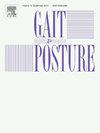Gait temporal parameters estimation in toddlers using inertial measurement units: A comparison of 15 algorithms
IF 2.2
3区 医学
Q3 NEUROSCIENCES
引用次数: 0
Abstract
Background
Children’s motor development can be evaluated through the analysis of gait temporal parameters and their variability. This requires the detection of gait events in a real-world environment, which can be achieved using inertial measurement units. Algorithms have been previously developed for healthy adults; however, the performance of these algorithms in the detection of gait events in toddlers has not been analysed.
Research question
Can inertial measurement units be used to analyse gait temporal parameters in toddlers?
Methods
Fifteen previously published algorithms using sensors attached on the lower-back or the ankles were used to identify gait events and calculate gait temporal parameters. A total of 1388 initial and 1388 final foot contacts collected from 15 toddlers were included in the analysis. The performance of the algorithms was compared against a GAITRite mat in terms of accuracy and precision. Accuracy in the measurement of gait temporal parameters was evaluated using Bland Altman limits of agreement for repeated measurements, and precision was assessed through the evaluation of correctly identified, falsely identified and missed events.
Results
From our results, no algorithm emerged as a best option from all those analysed. Algorithms using the ankle sensors provide higher accuracy and perfect precision when using only angular velocity about the medio-lateral axis. The best algorithms using the sensor attached at the lower-back use the resultant or global acceleration that reduces the effect of the sensor’s alignment. These lower-back-based algorithms compared to the best ankle-based ones have similar accuracy for the calculation of stride time and higher accuracy for step time; however, they do not have perfect precision.
Significance
Inertial measurement units can support research analysing the temporal parameters of toddlers’ gait in controlled environments, and may allow future studies in natural, free-living environments that can improve the monitoring of gait in young children.
求助全文
约1分钟内获得全文
求助全文
来源期刊

Gait & posture
医学-神经科学
CiteScore
4.70
自引率
12.50%
发文量
616
审稿时长
6 months
期刊介绍:
Gait & Posture is a vehicle for the publication of up-to-date basic and clinical research on all aspects of locomotion and balance.
The topics covered include: Techniques for the measurement of gait and posture, and the standardization of results presentation; Studies of normal and pathological gait; Treatment of gait and postural abnormalities; Biomechanical and theoretical approaches to gait and posture; Mathematical models of joint and muscle mechanics; Neurological and musculoskeletal function in gait and posture; The evolution of upright posture and bipedal locomotion; Adaptations of carrying loads, walking on uneven surfaces, climbing stairs etc; spinal biomechanics only if they are directly related to gait and/or posture and are of general interest to our readers; The effect of aging and development on gait and posture; Psychological and cultural aspects of gait; Patient education.
 求助内容:
求助内容: 应助结果提醒方式:
应助结果提醒方式:


